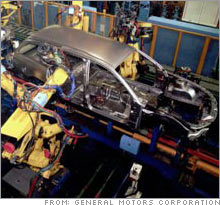What GM and Chrysler should be discussingNo, GM isn't going to buy Chrysler. But there might be some leftovers at the bargain counter that could prove attractive, argues Fortune's Alex Taylor.NEW YORK (Fortune) -- Of course, the idea of GM (Charts) buying Chrysler is preposterous. GM's biggest problem is overcapacity, and Chrysler is full of things that GM already has too much of: assembly plants, workers, retirees, car brands, car models, and dealers. For more than a decade, GM has been trying to slim down; acquiring Chrysler would only fatten it up again. If that isn't reason enough, consider this: Try to think of one automotive takeover that has actually worked. There haven't been any successful ones in modern memory but there have been plenty of failures: Renault-American Motors; Ford-Jaguar; Studebaker-Packard. These things always look good on paper but then collapse in the execution.  There is a reason why Carlos Ghosn didn't try to merge Renault and Nissan -- he knew it wasn't worth the effort. The idea that GM would want to buy Chrysler's sales volume so that it could remain Number One in the world is hilariously dumb. GM needs to get stronger, not bigger. But if Chrysler were to be broken up, and all its parts chucked into the bargain bin, that's a different story. Picking around the pieces, GM could find some attractive deals. Here are a few: The Jeep Brand. Although Chrysler has done its best to dilute the value of this American icon by building vehicles that are challenged in quality and functionality, the Jeep name still resonates with buyers. GM hopes that Hummer can some day challenge it, but in-your-face Hummer represents only a subset of the whole off-roading culture that Jeep can lay claim to. Taking on Jeep, and leaving Hummer to the X-games people, would be a smart move. Diesel engines. Modern diesel engines offer one possible solution to the alternative energy problem. American automakers have been slow to jump aboard because they believe that consumers hate them. But diesels are no longer smoky and smelly, and they provide excellent mileage. Chrysler has access to Daimler's diesel technology, which is top-drawer. GM is so far behind the curve that it entered into a disastrous deal with Fiat a couple of years ago largely to tap into its diesel expertise. The Dakota midsize pickup. GM dropped the ball when it redesigned its small pickups, the Chevy Colorado and GMC Canyon, and didn't leave any room in the engine bay for a six-cylinder engine. The Dakota is a sturdy and successful truck that has got room to grow if customers start tiring of their fuel-thirsty V-8 powered fullsize trucks. The Chrysler Technology Center. The gleaming black structure off I-75 north of Detroit was one of Lee Iacocca's better ideas. He consolidated all of Chrysler's far-flung engineering and research facilities under one modern roof and used the new building as a recruiting tool. GM could do the same thing. Its engineering complex in Warren, Michigan, with its flat-roofed, Saarinen-designed buildings made sense back when GM controlled 50% of the U.S. market. Today it looks dated and ragged around the edges. GM could sell the land for a golf course or housing development and move into smarter facilities up the road. People. Although GM has a solid team of executives, it could cherry-pick from the Chrysler roster. Would Chrysler COO Eric Ridenour be a worthy successor to 75-year-old GM vice chairman Bob Lutz? Might not some young Chrysler designers add flair to GM's already-improving staff? And how about some of that sharp Chrysler marketing talent to rejuvenate GM's efforts? So, picking and choosing, it is possible to find some jewels in the Chrysler wreckage that would benefit GM. But all this feels like arguing about the number of angels that can fit on the head of a pin. The U.S. auto industry is in a period of consolidation that is probably only about 50% complete and new entrants will continue to whittle away at the market share held by American automakers. By the end of the decade, cars made in India and China will likely start arriving in the U.S. and there is no end in sight. If GM expects to survive this influx, it will have to continue to make better use of its global resources and not be distracted by ill-conceived mergers. As for Chrysler, it would be better off staying attached to Daimler. If anyone knows how to fix Chrysler, it is DaimlerChrysler (Charts) chairman Dieter Zetsche. And so far, Daimler's investment in Chrysler looks cheap compared to its other fiascos involving Mitsubishi and Smart -- and has a lot more upside. |
Sponsors
|
